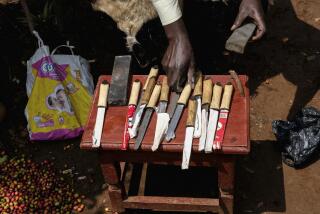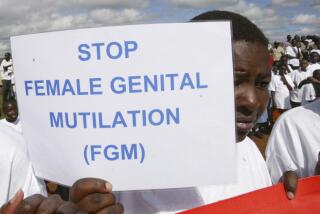Circumcision campaign in Africa reduces HIV infections 76%, study finds
A circumcision campaign in a South African township cut new HIV infections among the treated men by 76%, researchers reported Wednesday. The simple operation provides a way to make major inroads in the HIV transmission rate in countries where the infection rate is very high, researchers said, and provides a cost-effective way to slow the pandemic.
Clinical trials have shown that circumcision can reduce HIV infection, but the new results presented at a Rome conference of the International AIDS Society show the benefits in actual practice.
Using funds provided by international donors, physicians offered free circumcisions to all men over the age of 15 in the South African township of Orange Farm, which has a population of about 110,000. About 20,000 men participated in the program between 2007 and 2010, increasing the proportion of circumcised males in the township from 16% to 50%. Among men 15 to 24, the proportion circumcised reached 59%.
Dr. Bertran Auvert, a professor of public health at the University of Versailles in France, and his colleagues studied about 1,200 men in the township in 2007 and a similar number in 2010. They found an average of 2.86 HIV infections per 100 uncircumcised men, compared with 0.42 per 100 in men who had undergone the procedure. After statistical adjustment, that worked out to a 76% reduction in infections. There is no evidence that the circumcised men were more likely to use condoms or otherwise change their behavior.
The team is now looking to see if the procedure benefited women as well.
It is not completely clear why circumcision is so beneficial. Some studies have shown, however, that the folds of the uncircumcised tip provide a pocket for viruses and bacteria to grow. The foreskin is also known to have high concentrations of the cells that are infected by HIV.
Other African countries are also scaling up circumcision efforts. Kenya has circumcised nearly 290,000 men in the past three years, primarily in the province of Nyanza, according to the World Health Organization. The government of Tanzania has announced plans to circumcise at least 2.8 million men over the next five years. A rapid results campaign in early 2011 yielded 10,000 procedures. Swaziland, which has the highest HIV prevalence rate in the world, plans to circumcise 152,800 men. A statement released by the U.S. embassy in Swaziland estimated that the circumcision plan there could prevent nearly 90,000 new infections and save more than $600 million over the next decade.
Each circumcision in South Africa cost about $108, said Dirk Taljaard of Progressus Research and Development Consultancy in Johannesburg, one of the study authors. He estimated that circumcising five men would prevent one new HIV infection in the next year and that every dollar spent on the procedure would save about $15 that would have later been spent on treatment.
More to Read
Sign up for Essential California
The most important California stories and recommendations in your inbox every morning.
You may occasionally receive promotional content from the Los Angeles Times.









